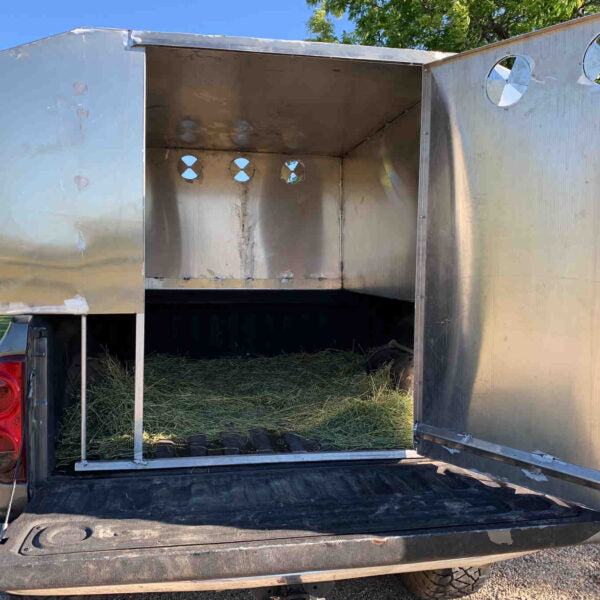My Store

Transporting Goats: Space, Optimal Ventilation, and Suspension
Transporting Goats
Transporting goats is a bit of a science. Of course anyone can pack car full of gear and haul a trailer full of goats, but it's important to take these considerations to mind to transport safely and efficiently. In this video Marc Warnke, "The Goat Guy," goes over the essentials of transporting goats. Space, Optimal Ventilation, and Suspension. For more information on this specific hauler design or if you'd like one custom built to your truck, click here. This topic is important for all goat owners and especially important for goat packers.
As packers, it is much more common that we transport goats; sometimes over great distances. Know the most important factors to safe goat transportation. This blog post covers part of a section of our Baby Goat Course. For everything you need to know on how to raise a goat in it's first year, check out the How to Raise a Baby Goat Course.
Space
The first variable to consider when transporting goats is space. When thinking of space you must first consider your goats. Planning to transport 4 or 5 Nigerian Dwarfs looks different than transporting 4 or 5 adult Kikos. Marc's design is based on transporting adult, horned pack goats. Goats actually prefer smaller spaces in terms of width when transporting. Adults tend to stay standing while on the road and will lean into each other or on the walls for stability. Too much width and they will all be 'floating' which increases stress and weariness from constantly fighting to maintain balance. This is especially true on rough roads like most trail head accesses are. The width of the back of a standard pickup bed is the approximate minimum width for 6 adult pack goats.
Height is also an important variable. Large horned adult packers may struggle to fit under a standard pickup camper shell. Many goats will still struggle even in tall shells. In Marc's experience, having a minimum of 54 inches of headroom is ideal for large pack goats. Baby goats tend to lie down for transport however they learn to stand as they get older. An ideal transportation set up would designate individual stalls for each goat so they could transport lying down as adults without fears of being stepped on or horned. Unfortunately, the space required for such a set up is often inefficient and expensive.
Optimal Ventilation
Ventilation is one of the most important considerations when transporting goats. Goats are prone to respiratory irritation and illness, especially as a result of poor transportation practices. Too little ventilation can cause issues from limited fresh air supply and inhaling fumes from their own waste and urine. We all know the smell of cleaning out nasty soaked hay from bedding areas, imagine being enclosed with it for several hours... Too much ventilation can cause issues due to debris. Straw and hay are very dusty and full of small particles. Driving down the highway can essentially cause a dust tornado in your trailer or hauler that irritates the eyes and respiratory system. You get the picture.
Both of these problems ultimately cause more stress or 'wear' on your goats and can potentially lead to problems. Climate and weather can also play a big role in these issues. If it's raining sideways and you have an open cage style hauler, regardless of comfort it can create health issues for your goats. Likewise with a nearly completely enclosed trailer, if it's 100 degrees out it can be very harmful.
The ideal ventilation solution is to create controllable, linear air flow. Having the capability to adjust the amount of direct airflow passing through your trailer or hauler is incredible. On hot days, open it up, in the winter minimize it a little more. The goal is for air to enter and exit from above without creating a tornado affect in the middle. Air should pass across the top of the hauler and leave the chaff and dust undisturbed on the floor. The best way to tell if your hauler is creating a tornado or not is by checking your goats' backs after transporting them. If their backs are covered in dust and chaff, you've got a constant whirlwind going on. If they are clean like you just loaded them in, air movement is not disturbing their bedding.
Suspension
Suspension is often a less considered concern when it comes to transporting goats. In all reality, suspension possibly has the greatest affect on a goat's performance immediately after transporting. The best way picture it is 1 hour of transportation = 2 hours of trail time with load. When being transported, goats are constantly shifting their balance or 'fighting the invisible man'. Not only this but if there's new kids on the block they may be avoiding being in the wrong spot in line while being bounced around. You get the picture. Transportation is physically exhausting for goats. So, Marc's rule is any transport time greater than 3 hours, it's best to sleep at the trail head and pack in at morning. This allows everyone to rest, refuel, and be ready to go.
Single axle trailers are the worst options when it comes to suspension. The worst of the worst are converted small utility trailers. They have little to no suspension and every bump makes them literally bounce. Single axle trailers pose a threat to both the goat's safety and your own. If a tire blows on a single axle trailer, it can be bad news at best, deadly for any involved at worst.
Double axle trailers are better in the sense that they provide additional safety margin in the case of a blow-out. Also, dual axles help span bumps and dips. As the first while spans a gap, the second supports the trailer. As the second spans a gap, the first supports the trailer. Its as if you graded all the high points of the road into all the low points. It makes for a much smoother ride. That being said, it can still be a rough go of things.
Vehicle suspension is the best option when transporting goats. Our own vehicles are designed with the most robust and advanced suspension systems for our own comfort and safety. It also makes the best option when transporting animals. Building a hauler into a vehicle combines the best of all worlds and minimizes stress and wear on our goats.
Final Considerations for Transporting Goats
- There's a lot of gear that goes along with goat packing. Storage space is important to consider. It all depends on the number of people, goats, and the amount of gear required. Combining storage into your hauler is a great solution for keeping seat space available and not taking extra vehicles.
- It's often not necessary to tether goats when transporting if they're used to the 'regular crowd'. However, it can be beneficial when adding new members.
- If goats are not tethered, it's a good idea to remove their collars during transportation.
- When loading goats, load the most submissive first. Alfas will tend to deter or pound others as they enter making loading difficult.
- Remember to use certified WEED-FREE bedding for compliance with US Forest Service regulations.
- It's helpful to gently lay down flakes or shingles of bedding rather than shaking it out and loosing all the dust and debris.





